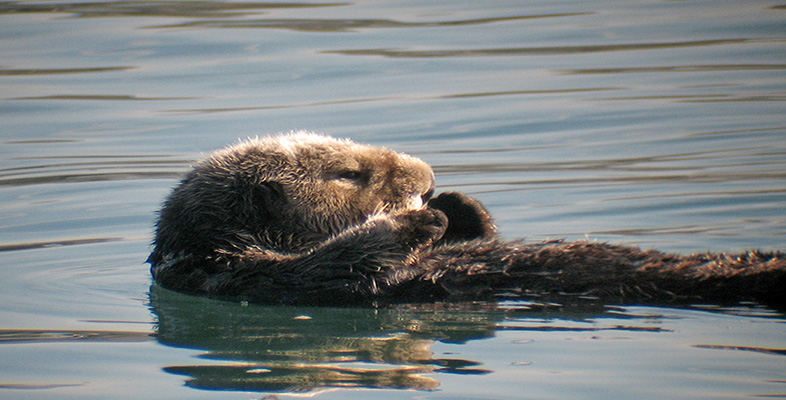2 Living in the water
2.1 Land versus water
Mammals share a number of biological characteristics that mark them out as members of the class Mammalia. Many of these are adaptations to a life on land. For example:
Mammals give birth to young at a relatively advanced stage of development and feed their young on milk.
Most mammals have hair, or fur, covering part or all of the body.
Mammals have a high metabolic rate and maintain a relatively high and constant body temperature, irrespective of the temperature of their environment.
Most land mammals walk or run with a leg at each corner - a limb pattern they share with most other land vertebrates, including reptiles (except snakes and legless lizards) and most amphibians.
Mammals breathe air and have a four-chambered heart, allowing them to split their circulation into a system for passing blood through the lungs and a system for transporting oxygen-rich blood around the body.
Almost all mammals can swim to some extent - even bats - and many make their way into the water from time to time for one reason or another.
Activity 1
Watch the TV programme from 00.35-08.56, which shows an elephant swimming in the sea, a desman hunting in a river and sea otters off the Californian coast. As you watch, make notes about what might tempt a land animal into the water in the first place, and the main challenges it would face in the new environment. Note how the desman and the sea otters have overcome some of these difficulties, and the devices that allow another mammal, David Attenborough, to join the otters in the water.
Before you watch, you might like to know a little more about the evidence for DA's passing remark that elephants might have adopted a semi-aquatic way of life at some point in their evolutionary history. The lungs of modern elephants are surrounded by loose connective tissue, not the bag-like 'pleural cavity' found in other land mammals, and this allows them to resist some of the damaging effects of water pressure. In addition, the kidneys of elephant fetuses possess features that are common in aquatic mammals but not land mammals. If the theory is true, the ancestors of today's elephants must have moved into the water and then returned to the land, while their sirenian cousins went on to become fully aquatic.
Answer
The obvious attraction for the desman and the otters is food, but other mammals might take to the water to escape from predators, pests or extremes of temperature. (The elephant is now a land mammal, of course, but it enters the water to drink or bathe and it can swim across open water using its trunk as a snorkel.)
The main challenges for the desman appear to be holding its breath long enough to find and catch its food, moving about in the strong current and staying warm in the water. The sea otter also holds its breath while it uses webbed feet and a rudder-like tail to search for food in shallow coastal waters, and its thick fur keeps it warm enough to live in Alaskan seas. DA can join the otters, thanks to a snorkel (for breathing), fins (for moving about), a wetsuit (for staying warm) and a mask (for seeing in the water).
Watching the TV programme you might have thought of other examples of aquatic mammals: both the yapok (a marsupial) and the platypus (a monotreme) are very much at home in the water, despite the demands of that environment. The challenges that face the platypus, desman, sea otter and DA are common to all aquatic mammals. They are the result of matching their mammalian characteristics against a number of differences in the physical properties of air and water, the most important of which are listed below.
Water contains less oxygen than air does.
Water is denser and more viscous than air.
Water has a higher specific heat and a higher thermal conductivity than air. (I'll explain these terms later.)
Light is much more readily absorbed by water than by air and visibility in water is often poor because suspended particles make it turbid.
Sound travels faster and further in water than it does in air.
